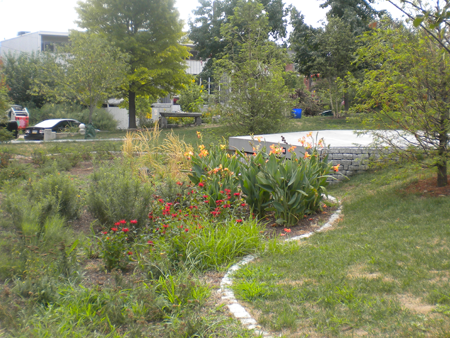
A rain garden manages stormwater at Liberty Lands Park, Northern Liberties.
During our last blog series we talked about how the rising costs of “big ticket items” are a large part of what’s driving PWD's rate adjustments. We should also explain that we aren’t proposing these adjustments without first doing everything we can to balance increasing costs with cuts to our expenses.
Some of the most significant savings come from the Green City, Clean Waters plan. This is the City of Philadelphia's plan to meet requirements for reducing the overflow of sewage into the Delaware and Schuylkill rivers during rain storms. While other cities have been faced with costs as high as $8 billion for creating entirely new tunnels to separate storm water from waste water, PWD will spend about a quarter of that over the next several years on green infrastructure meant to keep much of the storm water from ever entering the system. The end result: fewer streets torn up for months to install new tunnels and more trees and other greenery throughout the city, providing cleaner air and water while reducing the urban “heat island” effect that cooks us each summer.
These are investments that will pay off down the road in lower maintenance costs, less strain on the current infrastructure and fewer gallons of water that need to be treated at our sewage treatment plants. This doesn’t even begin to capture the lower costs that will come from an overall healthier, cleaner environment when you factor in lower healthcare expenses and less need for massive clean-ups of our rivers and streams.
It’s a win-win… a less expensive way of enacting these mandated measures to clean up our stormwater process and lower costs down the line as we realize the benefits of these investments.
For more information about Green City, Clean Waters, check out the Year in Review to see how far we’ve come already and learn more about where we’re going. For a highly technical analysis of the cost-savings from Green City, Clean Waters, view Section 9 of the plan which compares alternatives to the green infrastructure approach.
Have you noticed Green City, Clean Waters projects in your neighborhood? Share them with us on our Facebook page.